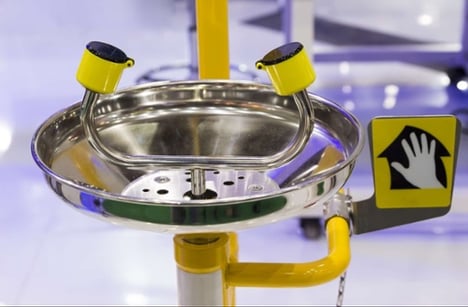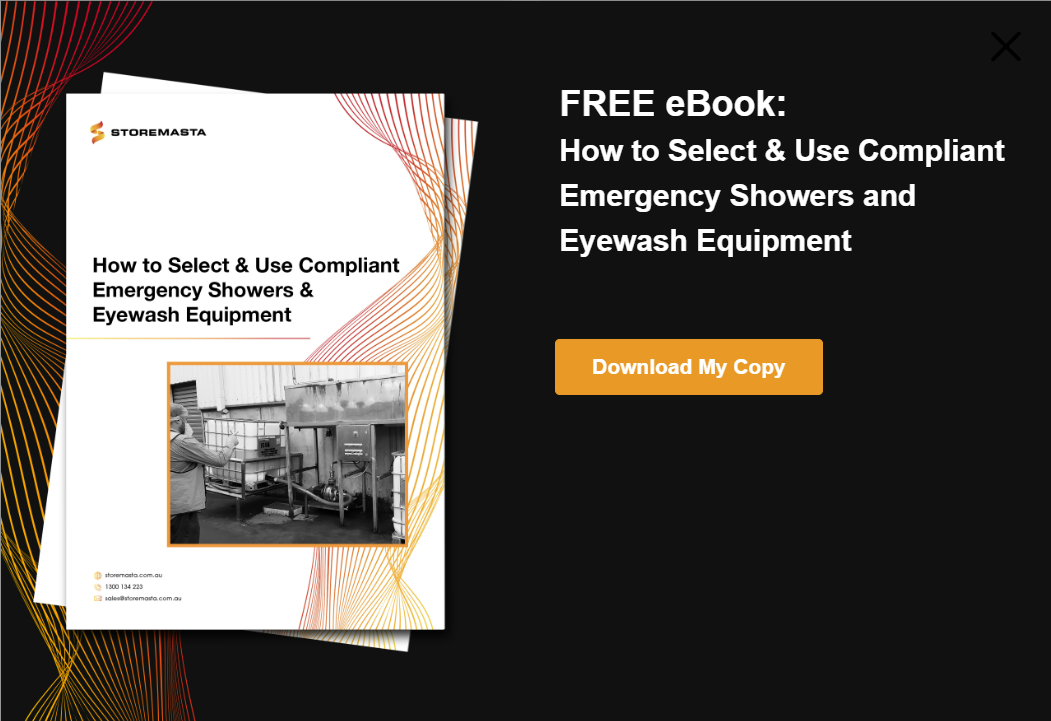Implementing good policy and procedures, especially at industrial worksites, is a critical component of work health and safety. This post is about the contribution that efficient and consistent housekeeping makes to the ongoing success and compliance of your emergency decontamination facility. Decontamination equipment, such as safety showers and eyewash stations, must be always accessible to an injured worker. Therefore, good housekeeping ensures the area is always kept free of obstructions, incompatible materials and other hazards.
Obstructing the Path to the Emergency Decontamination Station
Housekeeping in the workplace is more than emptying rubbish bins and sweeping the floor. It’s also about having dedicated spaces for machinery and tools, as well as efficient storage for equipment, chemicals, and cleaning materials.
Good housekeeping is important for emergency decontamination facilities, as well as your chemical storage and handling areas. Housekeeping is part of ongoing maintenance and compliance, ensuring that your controls and safety equipment continue to operate to optimum levels.
Of course, it’s essential to keep aisles, walkways and emergency exits clear for health and safety. However, don’t forget that it’s also crucial that you train your workers to keep the areas near, and leading to, decontamination stations clear and free from obstacles.
It’s a requirement of the Australian Standard AS 4775 - Emergency eyewash and shower equipment that the path of travel between a worker and a shower/eyewash unit must be free of any obstructions that could inhibit the immediate use of the equipment.

Access to your emergency decontamination equipment must be free of obstructions that may slow down or prevent staff from quickly accessing the safety shower or eyewash facilities.
At the same time, an obstacle could restrict visibility of the decontamination station and make it difficult to see. The station must also be highly visible according to the Standard. ‘Emergency Shower’ or ‘Emergency Eye Wash’ signage should also be erected to ensure staff know where the facilities are situated.
REMEMBER: There are many aspects to keeping your safety shower and eyewash facilities compliant. Read our popular blog to find out more.
Common Obstacles To The Emergency Decontamination Station
While safety showers, drench hoses and eyewash stations are an essential part of site safety, making sure that they are visible and readily accessible for staff is of the utmost importance.
You need to make sure that your facilities are in a practical, convenient and safe location that doesn’t have obstacles in its path when staff are rushing to wash their eyes, hands or bodies from hazardous chemicals.
Some common obstacles to the emergency decontamination station may include items located in the wrong place, such as:
- Chemical storage
- Vehicles or equipment
- Discarded packaging or waste
- Deliveries
- General workplace supplies
- Work desks
- Electrical equipment or devices
- Populated areas of the workplace
See our table below to see a basic breakdown of the hazard, example and strategy to rectify any obstacles that may be blocking or interfering with the pathway to emergency decontamination facilities in your workplace.
Examples of Hazards in Emergency Decontamination Areas
| Hazard | Examples | Strategies |
|---|---|---|
| Slip hazards that could delay access. | Spilled water, oil, chemicals, sand, grease. | Have spill kits on hand, clean up spills immediately. |
| Tripping hazards that could slow down the injured worker. | Loose flooring, extension cords wires and cables, debris. | Ensure staff and contractors keep work areas clear. Have broken items repaired immediately. |
| Vehicles and loading equipment that could block access. | Forklifts, trucks, gas bottle trolleys parked in front of the eyewash/shower station. | Have dedicated parking spaces for vehicles. Train external contractors and workers from other departments to park vehicles correctly. |
| Waste materials and debris left lying around that could impede access. | Discarded packaging materials and stretch wrap, empty containers, broken pallets. | Install waste receptacles and recycling collection points. Ensure supervisors enforce housekeeping policies. |
| Temporary workstations in the direct path of the decontamination equipment. | Maintenance contractors carrying out repair work and leaving their tools in the path of workers. | Allocate specific areas for maintenance work and provide contractors with supervision. |
| Supplier deliveries left out and not put away. | Raw materials, chemicals, cleaning agents, (on pallets or otherwise) not yet put away. | Purchase and install dedicated storage cupboards and safety cabinets so everything has a ‘home’. |
Importance of Housekeeping Policy and Procedures
One of the main reasons obstacles start to build up and clog work areas is when no one knows what to do with the items.
Maybe a supplier order arrives and the door to the chemical store is locked, or the shelves in the warehouse are full, or an untrained worker is assigned the task of putting stocks away. Supervision, purchasing procedures and staff training are all essential to efficient housekeeping.
Housekeeping will ensure that your work areas, including those vital emergency shower and eyewash stations, are kept clean, tidy and accessible.
IMPORTANT: Good housekeeping practices also ensure that lightbulbs are cleaned and replaced so that work areas remain well-lit. It’s a requirement of Australian Safety Standards that areas being served by safety showers and eyewash stations are properly illuminated at all times.
Blocked Emergency Access Points
Do you have any items lying around your workplace that are creating an obstruction between the decontamination facility and an emergency access point. Injured workers using emergency eyewash and showers may require immediate care and evacuation by paramedics, particularly if they have been exposed to highly toxic or corrosive chemicals.
Here are some things to consider:
- Is there equipment, materials, or machinery that could delay emergency services reaching the decontamination station?
- Emergency responders may need to bring bulky medical equipment (eg, O2, evacuation trolleys, PPE and breathing apparatus. Could anything obstruct this?
- What obstructions might interfere with a paramedic’s ability to evacuate an injured patient?
REMEMBER: Items lying around work areas can also create additional fire hazards or could increase a worker’s exposure to dusts and airborne contaminants.
Incompatible Materials in the Area
Good housekeeping also ensures that incompatible substances and materials are not kept in work areas. This especially includes anything that could react dangerously with water once your emergency shower and eyewash equipment is activated.
For safety in your emergency decontamination areas, consider if your work area has:
- Worn or damaged electrical fittings and sockets that could create an electrocution hazard.
- Chemicals that are incompatible with water including Class 4 Dangerous Goods.
REMEMBER: Developing operating procedures for your safety showers and emergency eyewash stations is an important safety consideration. Read our post on how to develop these procedures for your decontamination equipment.
Housekeeping Station
Your housekeeping station should be properly stocked with the necessary items to clean, maintain and organise your work areas, including your safety shower and eyewash facilities.
This includes suitable cleaning products and absorbents, that are suitable for your decontamination equipment. Remember, cross contamination can occur if your safety equipment isn’t being used and maintained as it should be.
IMPORTANT: Discover the 5 essential practices to ensure your emergency decontamination facilities are kept effective by reading our informative blog post.
Follow Manufacturers’ Instructions for Emergency Decontamination Equipment
Refer to the manufacturer's instructions for your emergency shower and eyewash facilities, to find the correct method for:
- Operation – the decontamination process may be compromised if the proper procedures aren’t followed with operation. Make sure your staff are trained in the correct procedure for using emergency decontamination equipment.
- Inspection & Testing – regular inspections of your decontamination equipment will allow you to note any issues with the safety shower or eyewash station, as well as ensure the cleanliness of the equipment. It’s a requirement of AS 4775 that plumbed emergency showers and eyewash units must be activated for testing at least once per week, so water is always in the area.
- Maintenance – just like any type of safety equipment or chemical control, inspections may note maintenance issues which require rectification. Contaminants, such as hazardous chemicals, can’t be washed off your staff if the equipment isn’t performing as it should.
Make Sure Your Safety Equipment is Complaint
Housekeeping is only one consideration when installing and using emergency eyewash and showers. For more detailed guidelines we recommend downloading our free eBook How to select and use compliant emergency showers and eyewash equipment. Download and read it to day to learn how to keep your decontamination facility compliant and working efficiently.
Joining the team as a Dangerous Goods Storage Consultant, Melissa Hampton became Storemasta's Marketing Manager in late 2021. With extensive knowledge and experience in chemical compliance, Melissa is responsible for leading the Marketing team and helping shape their marketing strategy. In her spare time, you can find Melissa hiking, swimming and enjoying the great outdoors in beautiful north-west Tasmania.
